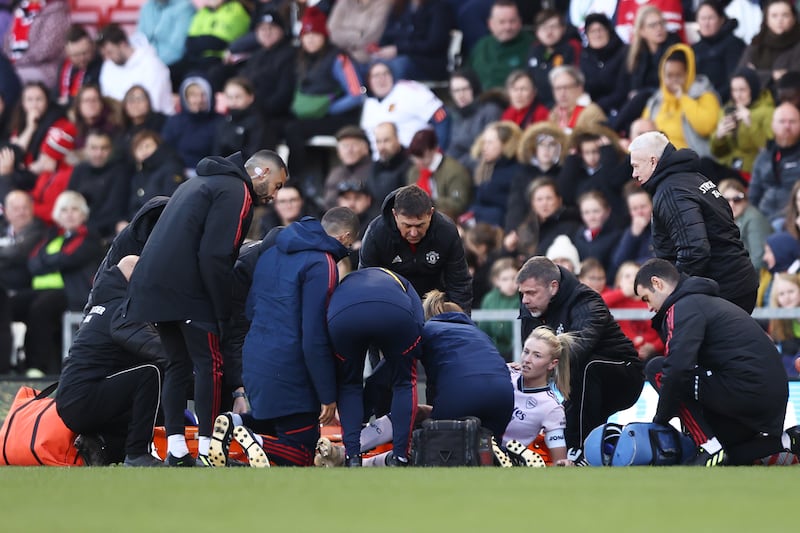A lack of gender-specific research in sport leaves girls and women more at risk of injury than male competitors, aggravating disparities already in the sports system, a leading academic fears.
Head of the Department of Sport and Health Sciences at TUS Athlone, Dr Aoife Lane, says research is “not counteracting a lot of the biases or challenges girls have had to overcome” in sport, with just 6 per cent of sport and exercise science research focusing exclusively on female participants.
The SHE Research Group, based in TUS Midlands and of which Dr Lane is a member, aims to address this research gap so that female athletes may be better prepared and supported.
Dr Lane says that although “not all research done on male athletes is not relevant or appropriate”, too little effort has been made to understand how the health and performances of women athletes are particularly affected by factors such as menstruation, nutrition, biomechanics and even the set-up of the overall sporting system.
Even the effects of hormones – an area where we know men and women differ – are insufficiently understood. “In recent years we’ve realised that we haven’t really studied injury, performance or recovery in the context of our biological hormones, like the menstrual cycle,” says Dr Lane.
“We’ve never checked to see if those things impact in a positive or a negative way on performance, injury, recovery. So that’s probably in its infancy.”
Attempts to address this knowledge deficit include work being done by Irish researcher Prof Kirsty Elliott-Sale on how factors such as menstruation and contraception affect women doing sport or exercise.
The gender gap in research is all the more costly because much of the data that does exist highlights female participants’ vulnerability to certain injuries.
Research led by Dr Dan Horan, formerly the FAI’s head of football science and research, looked at injuries in elite-level women’s soccer in Ireland over a two-year period.
The research found that lower-extremity injuries accounted for 85 per cent of the 266 injuries recorded.
Lateral ankle sprains were the most common injury, accounting for 13.9 per cent, followed by hamstring strains (12.4 per cent). There were also eight (3 per cent) anterior cruciate ligament injuries (ACL). Lane says the rate of ACL injuries suffered by female players equates to more than double the rate suffered by males.
ACL injuries in women’s sport have provoked discussion recently not just because of the growing interest in women’s sport but because of their sheer number among top professional athletes.
In soccer, Spain’s Alexia Putellas missed out Euro 2022 after tearing an ACL a day before the tournament was to begin, and last year’s World Cup was denied the talents of Viv Miedema (Netherlands), Leah Williamson and Beth Mead (both England) due to similar injuries.

Too little is known about why women are more likely to suffer certain injuries. Is it hormones? Menstruation? Biomechanics? All of the above? One thing that’s clear is more research is needed.
“It’s far more complex, there’s so many different reasons to it,” physiotherapist with the Republic of Ireland WNT Angela Kenneally says.
One factor that Kenneally, who is also a PhD candidate in female athlete health and performance, has noticed during her time with the Irish set-up – she worked with the underage system before moving on to the senior team – is the “strength or lack thereof” of the teenage girls with whom she has worked. This raises the issue of a resources gap, in addition to the research gap.
“You’ll never prevent injury, but [you can] certainly reduce them, and it comes down to exposing female players to the fundamentals of movement, but also strength and conditioning at a younger age.”
She has seen that differences between the conditioning of girls compared with boys start to appear in the early teen years.
“Girls change and puberty hits kind of earlier than boys, but we don’t actually adjust for that,” she says, adding that when girls stop playing with boys, they’re no longer exposed to the same conditioning work.
By the time these girls get to under-15/16, Kenneally says, their lack of strength and conditioning compared with boys of the same age is evident.
“Everybody puts value on lower-body strength as footballers, but you also need to have upper-body strength to hold off a tackle… The very simple thing of ‘can these players do a push-up?’ The majority can’t, or you’re looking at them during the warm-up, maybe they’re doing a few squats, and you can see that maybe their knees are coming in [indicating poor form and increasing the risk of injury].
“Simple things that you’re going ‘okay, there are definitely some discrepancies here’, and does that predispose them to injury? Yeah, it does.”
Particularly to lower-extremity injuries.
“When we’re talking about injury prevention, it’s all about the exposure that girls and women have to those landing mechanics on a consistent and repeated basis,” says Kenneally.
Dr Lane is adamant the inadequate conditioning is not a failing of girls. She says it’s the sporting system that needs to change.
“I think what we need to be better at is critiquing the context and the environment in where and how injuries occur.”
“Yes, there’s a lot of internal factors, but there are other factors, like what age do young female athletes start in strength and conditioning? What was the quality of the practitioner that did it [S&C] with them? ... When they do get injured, how quick do they get a scan? How quick do they get an operation? What’s the quality of the recovery plan?
“There’s all of these contextual factors before they ever get the injury in the first place that might actually contribute to the higher rate of injury and then there’s the aftermath.”
“[So] girls have to fight against a little bit more, and in return are we doing enough extra to balance it out? I don’t think we are,” Dr Lane adds.
“It’s not about ‘fixing’ girls, it’s about the system stepping up and going ‘how do we develop a sports system that’s suitable and equally supportive and fair for boys and girls and gives everyone a chance.”

But while we wait for the research to catch up, and the system to change, Kenneally stresses that we’re not entirely in the dark. There are still things individuals can do.
It’s the answer no one wants to hear, whether they play for Ireland or jog the odd few laps of a local park: warm up properly.
She highlights the Fifa 11+ injury prevention programme, a 20-minute warm-up routine designed to reduce the incidence and severity of injuries.
Despite being from Fifa, the exercises are not really sport specific. They focus on a few fundamental movements.
“They’re all really well researched, and we know that if you’re consistent with it, it works. Yeah, it might be boring, it can be annoying, but far less annoying and time-consuming than a significant injury.”
And back in the lab, there’s no shortage of willingness to get the research done.
“We want to do real high-quality studies that are inter-disciplinary. The energy and enthusiasm across the island in terms of higher education researchers, academics and students is unbelievable,” says Dr Lane.
“Everybody sees there’s urgency in policy and practice, and research as well, and doing something about this but doing it in a much more efficient way.”
However, she says they also have their part to play in making sure their findings end up where they’re needed, helping girls and women in their chosen arena.
“We’re still learning too, so it’s making sure that as we learn and understand that we disseminate that information quickly but accurately so that as we’re learning the system is learning as well.”
“We’ve so much to catch up on that we can’t repeat the mistakes and just do research and put them in papers and not share them.”


















